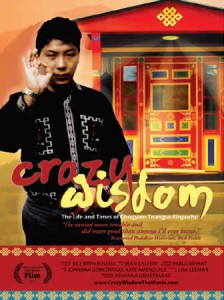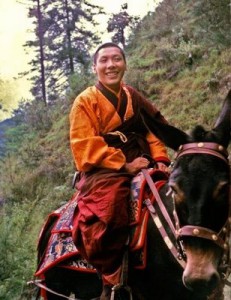Sunday
Community ArticlesThe Man With Many Faces: Remarks on the Film Crazy Wisdom
By Heather Grimes
Not giving up on anything seemed to be the basic point. Willing to work with what is there on the basis of a primordial wakeful quality seems to be the definition of Crazy Wisdom.
– Chogyam Trungpa Rinpoche.
Photos of Chogyam Trungpa Rinpoche are as much a part of our household as family and friends. His image is framed on table-tops and hung above the shrine. His words are ubiquitous as well. In print, dozens of his publications sit on the highest bookshelves in our house, having been read and re-read with comments flowing into the margins. And then there are his words we recite out loud as a community that come in the form of practices and chants. Plus his recorded talks and teachings in video and audio.
It is a thing of great fortune that the body and breadth of Chogyam Trungpa’s teachings have been documented in so many forms. I feel I’ve been well acquainted with each of these forms over the span of the last decade. And yet, once I’d viewed Johanna Demetrakas’ Crazy Wisdom, a film on the life and times of Chogyam Trungpa, I was left with the feeling that there in the dark, breezy shrine room, in the company of my Boulder sangha, I was being introduced to him for the very first time. I thought I knew the man by knowing his teachings, his legacy in images. As it turns out, I was wrong.
The whole is greater than the sum of its parts. Indeed this was case with Crazy Wisdom in so many ways. It was a forum, of sorts, for all the pieces to fit together.
The film opened with the words of the Sadhana of Mahamudra being spoken as footage of a masterful hand inscribed its words on paper, spliced alongside images of violence from the 1950s in Tibet. I’ve personally practiced the Sadhana of Mahamudra dozens of times, reciting words from the page, losing myself in the rhythm of the beating language. But as I watched the film, I heard it in an entirely new way. The Sadhana of Mahamudra would forevermore be infused with the reality of Tibet at the time when Chogyam Trungpa fled. It would never again leave my lips without that new level of understanding.
The invasion of the People’s Liberation Army into Tibet is one of the great historic tragedies of the 20th century. The culture suffered so deeply as their sacred treasures, teachings, monasteries and society were thoroughly assaulted. I had read that Chogyam Trungpa led a large group out of Tibet. I had read about the unthinkable journey they endured, how most of them starved, were captured or simply vanished. All this information had been gathered and logged away previous to the movie.
But watching it on film, I absorbed it in a deeper way. The images of Tibet—the hard-faced, bright-eyed people, the prayer flags lapping at the air—moved me. Hearing the words “13 out of 300 made it safely to India, we had to cut up and boil our shoe-leather for food” left me breathless. Not to mention the fact that the photo shown of Trungpa, the man who led the crowd, was of a man who was much younger than I am today. Since then, there have been countless nights spent stirring these images through my mind.
Had I not realized what he went through to get these teachings to us? Had I not understood what was required of him for me to be here today—with Sacred Path of the Warrior within arm’s reach, hours from doing evening meal chants with my husband while my toddler looks on from her high-chair, unwittingly absorbing a piece of the dignity that traveled across the world just over 50 years ago to reach her?
Trungpa’s journey across India could have easily filled the entire movie but it was simply the first of many voyages he embarked on to plant the seed of dharma in the west. Clearly I never thought it was as simple as making a successful delivery, an unfussy drop-off at the doorstep of an eager recipient. But, until now, I’d never seen the tribulations of his lifetime articulated with such a clear beginning, middle and end as they were in this film.
The story of the car-crash into the joke shop that left him paralyzed on his left side has been told far and wide, with the word ‘paralyzed’ receiving no more emphasis than the others and therefore easily blipped over. This was coupled with the fact that the majority of Trungpa images I lay my gaze on are still, unmoving, unable to portray paralysis, as it were. There he was in the film, limp on the left side, requiring aides to assist him with walking as he slowly hobbled to his destination. The man from the photos, I am acquainted with. The man behind the words and the teachings, I spend countless hours attempting to understand. And yet, this man on the screen who struggled so deeply, felt like a man I had never met.
The many faces of Chogyam Trungpa Rinpoche were depicted in a cascade of delicious images in this film, one worn with the same authenticity as the next, as he tirelessly worked the minds of his western students. There he was with a shaved head and suit in one moment, wearing a tie-dye and fedora in the next. He donned a cowboy hat chewing a sprig of wheat in one frame and was draped in glorious brocades in the next. He had on nothing but a hot cigarette wedged into smirked-lips (with a lovely blond in the background) on one day and wore exquisite Dorje Kasung attire the next. He met his students in whatever way was required to do his work most effectively.
With so many faces flanking the expansive body of teachings of Chogyam Trungpa Rinpoche, the boundless legacy, it could be easy to forget the seeds of dharma were planted by this one man, with his one huge heart in his one astonishingly short lifetime. By the end of Crazy Wisdom, as the film credits rolled and the lights rose, I felt as if I’d been invited for tea with the man himself, leaving me full-bellied and a bit speechless in his wake.
I stood and attempted to share this (during the question and answer session following the film) as I looked out at the seamless expanse of fellow students through an unexpected spill of tears. Those who were his first students are now grown, many of them parents and grandparents. The ground has been laid and now it is essentially up to us, generation by generation, to embody the teachings he worked so tirelessly to transmit.
As I crawled into bed that night, still fumbling to find the right words, all I could think of was how appreciative I was to have this film to show my granddaughter one day, so that she would be able to have tea with the man behind the teachings as well.








Aug 14, 2011
Reply
I have been associated with the Shambhala lineage for more than 15 years. However, as a recovering born again Christian, following Trungpa as the personality never went well with me. I have been overly suspicious and skeptical of following any one person. Yet over the years, though, as I read his books and came to admire and appreciate the great clarity of his voice and of the great benefit that the teachings have brought to me, my curiosity of Trungpa has grown. Nowadays I find myself more curious than ever as to the man who had such profound influence on a generation of people. One who has, perhaps, done more for bringing Buddhism to the west than any other of his contemporaries. I find myself with one question: “who IS this man?” Unfortunately, I will not be able to discover this in person. But I am learning who he is through his students, teachers, lineage holders, teachings and the sangha. Together they make a mosaic of the man as he is now.
Jul 7, 2011
Reply
I think that I was on the periphery of the scene, so to speak and yet just as in a mandala somehow I too was at the centre. I became a zen student of Roshi Kapleau – One day Roshi Kapleau was complaining of a bizarre letter that Rinpoche had sent him. -I was of course standing right there while he complained to his head monk. At that time I was in full flight away from Trungpa-and I didn’t object to the Roshi calling him crazy-Well who would-right? But the next day Roshi Kapleau made a point of telling me what a great teacher Trungpa was – to people like Allen Ginsberg, who Roshi knew personally-and how Trungpa had made such a difference in their lives. I guess it was inevitable from that point on that I would be making my way back to him. Of course I never left. In my life there was the time before Trungpa and the time after-nothing would be the same again. I will be forever grateful!
Jul 7, 2011
Reply
Heather, I thought your article was very well-written, and so heart-felt. It is great that the film reaches and touches those who never met Trungpa Rinpoche in so personal a way. I too saw the film (a sneak preview) here in Halifax, and especially liked the fact that it dealt with some of the controversial aspects of Trungpa Rinpoche’s life, even though I lived through them and found them non-conceptual more than controversial. I especially like Christie Cashman’s description of his inviting his students and their stash of grass up to his home at Four Mile Canyon, only to disappoint and astonish them by inviting them one by one to offer what they thought they would be smoking to the fire in the fireplace. Ordinary mind was always the point, not getting “high”. That was a very counter-counter culture thing to emphasize in those days, and I myself learned a great deal by following those instructions!
Jul 5, 2011
Reply
Younger students like me have what I call a “conditioned Messiah mentality” when it comes to teachers like Chogyam Trungpa. Unknowingly we like to compare spiritual leaders to Jesus. In a way we set ourselves up for inevitable failure because everyone is human with their individual paths and mistakes.
So the figure of Trungpa is controversial in this light because there were many mistakes.
However what keeps me engaged are the teachings and transmission through the sangha. Put simply his teachings work and that’s what matters to me.